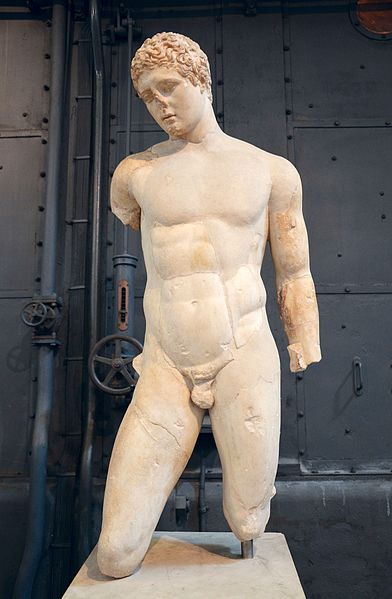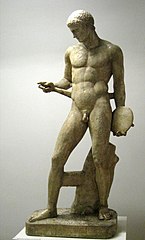Discophoros, Incomplete – Athlete With Discus
source: Wikimedia Commons
author: Carole Raddato
Description
A photograph frames a marble statue of a nude man missing portions of his limbs. The sculpture’s right arm and left hand are missing, as well as both legs below the knees. The statue bears signs of wear and old age.
Date
Artifact: original c. 2nd century AD (see below)
Photo: August 2015
Information
This is an ancient copy of Discophoros, a series of Roman marble reproductions of a Greek bronze work thought to originate from the 4th century BC. This copy was excavated from Piazza Bocca della Verità in Rome, Italy in 1895. Several Roman copies of the statue have been discovered, the oldest of which, though missing its head and all four limbs, dates to the 2nd century AD. Later copies include more of the limbs and a discus held in the left hand, allowing modern reproductions to be more detailed. The range of Roman copies and modern copies of the statue, many of which take some liberty with its form, have led to quite a number of variations of the work. Some other variations are linked below.
In more complete reproductions of the statue, the athlete holds in his left hand a Greek discus, which was used in the discus throw. This was one of the five sections of the pentathlon, an event featured in the ancient Olympic Games and other Panhellenic festivals.
At the time of photograph, this work was housed in the Centrale Montemartini, located in Rome, Italy.
Other Copies
Related Articles
Greek Discus | Greek Pentathlon | Ancient Olympic Games | Panhellenic Games
[raw_html_snippet id=”bib”]
Scanlon, T. F. (2014). Sport in the Greek and Roman worlds. Vol 1. Oxford: Oxford University Press.
Zarnowski, F. (2013). The pentathlon of the ancient world. McFarland.
[raw_html_snippet id=”endbib”]



